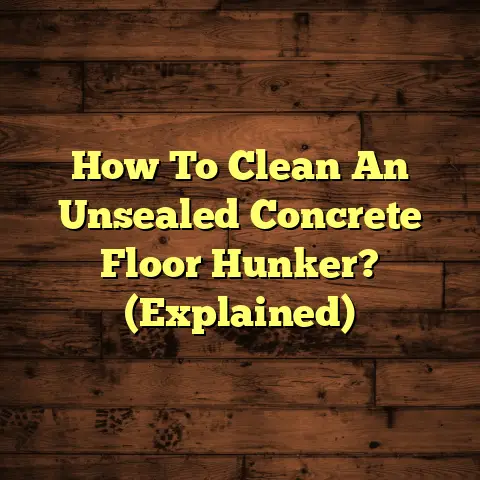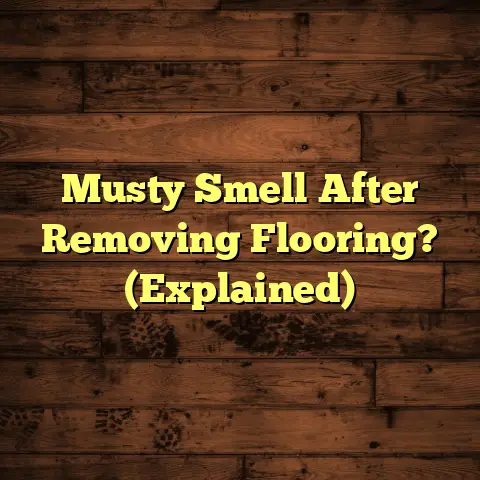Acid on Floor Tiles? (5 Reasons To NOT Do It!)
In the world of modern home design, how your place looks is super important. We all want that sleek, clean vibe, right? High-quality materials and minimalist designs are all the rage.
That’s why keeping our floor tiles sparkling is a big deal. I’ve seen so many homeowners tempted by quick fixes, like using acid to clean their tiles. The idea of gleaming, spotless floors is definitely appealing.
But before you reach for that bottle of acid, let’s pump the brakes. There are some serious downsides you need to know about.
Thesis Statement: I’m going to break down the five biggest reasons why using acid on your floor tiles is a bad idea. We’ll look at how it can mess up the look of your tiles, put your safety at risk, shorten their lifespan, and cost you a fortune in the long run. Trust me, there are better ways to keep your floors looking fabulous!
Section 1: The Aesthetic Dilemma of Acid Use on Floor Tiles
1. Impact on Tile Appearance:
Okay, let’s talk about looks. Acid can seriously mess with the appearance of your tiles. I’ve seen it happen way too many times.
Different types of tiles react differently to acid:
-
Ceramic & Porcelain: Acid can strip away the glaze, leaving them looking dull and lifeless. I’ve seen vibrant colors fade and patterns become less defined.
-
Natural Stone (Marble, Granite, etc.): These are super sensitive to acid. It can cause etching, which is like permanent water stains that you can’t get rid of.
The big problem is etching. This is when the acid actually eats away at the surface of the tile, creating a dull, uneven texture. It’s basically irreversible damage. Once it’s done, you’re stuck with it.
I remember one client who used acid on their marble entryway. The result? A cloudy, uneven surface that completely ruined the elegance of the space. They ended up having to replace the entire floor! Not fun, and definitely not cheap.
2. Loss of Texture and Design Features:
Modern tiles often have cool textures and intricate designs. Acid can obliterate these features.
Think about it:
-
Textured Tiles: Acid can smooth out the texture, making them look flat and boring. That cool, tactile feel? Gone.
-
Patterned Tiles: Acid can fade or even remove the patterns, especially if they’re delicately printed or painted on.
For example, those trendy encaustic-look tiles with the bold geometric patterns? Acid can wreak havoc on those. The vibrant colors can fade, and the sharp lines can blur, making the whole design look muddy.
I’ve seen acid ruin beautiful slate tiles, stripping away their natural texture and leaving them looking like plain, gray slabs. It’s a real shame because those textures are what give slate its character.
So, if you value the unique look of your tiles, stay far, far away from acid!
Section 2: Safety Concerns Associated with Acid Use
1. Health Risks:
Let’s be real: acid is dangerous stuff. It’s not something you want to mess around with lightly.
Here’s what you need to know:
-
Skin Contact: Acid can cause burns, irritation, and even severe tissue damage. I’ve seen people end up in the ER after accidentally splashing acid on their skin.
-
Inhalation: Breathing in acid fumes can irritate your lungs and cause respiratory problems. Prolonged exposure can even lead to serious lung damage.
-
Eye Contact: This is the scariest one. Acid in your eyes can cause blindness. Seriously, it’s not worth the risk.
Even if you’re super careful and wear protective gear (gloves, goggles, a mask), accidents can happen. A splash here, a whiff of fumes there… it’s easy to make a mistake.
And let’s be honest, most homeowners aren’t trained in handling hazardous chemicals. I’ve seen people try to use acid without proper ventilation, without gloves, even without eye protection. It’s a recipe for disaster.
According to the CDC, accidental chemical injuries result in thousands of emergency room visits each year. While specific data on acid-related flooring incidents is limited, the broader trend highlights the inherent risks of handling such substances without professional expertise.
2. Environmental Impact:
It’s not just your health you need to worry about. Acid can also harm the environment.
-
Water Contamination: When you rinse the acid down the drain, it can contaminate the water supply. This can harm aquatic life and even affect the safety of your drinking water.
-
Plumbing Damage: Acid can corrode your pipes over time, leading to leaks and costly repairs. I’ve seen entire plumbing systems destroyed by the constant use of harsh chemicals.
-
Ecosystem Disruption: Acid runoff can harm plants and animals in your yard and local ecosystems. It can disrupt the delicate balance of nature.
Think about it: you’re not just cleaning your floors, you’re potentially harming the environment for years to come.
Many municipalities have strict regulations regarding the disposal of hazardous chemicals like acids. Improper disposal can lead to fines and legal trouble. It’s simply not worth the risk when there are so many eco-friendly cleaning options available.
Section 3: The Durability Factor: Why Acid May Compromise Tile Longevity
1. Structural Damage to Tiles:
Acid isn’t just a cosmetic issue. It can actually weaken the structure of your tiles.
-
Weakening: Acid can dissolve the minerals that hold the tile together, making it more brittle and prone to cracking.
-
Cracking: Over time, the weakened tile can develop cracks, especially in high-traffic areas.
-
Chipping: Acid can also make the edges of the tile more susceptible to chipping.
I’ve seen acid eat away at the grout, creating gaps and allowing water to seep underneath the tiles. This can lead to even more damage, like mold growth and structural instability.
Think of your tiles as a team. If one tile is weak, it can put stress on the surrounding tiles, leading to a domino effect of damage.
According to the Tile Council of North America (TCNA), proper maintenance is crucial for extending the lifespan of tile installations. Acid-based cleaners are explicitly discouraged due to their potential to compromise the structural integrity of the tiles and grout.
2. Grout Deterioration:
Grout is the glue that holds your tiles together. Acid can destroy it.
-
Erosion: Acid can dissolve the grout, leaving gaps and creating a breeding ground for bacteria.
-
Discoloration: Acid can also stain the grout, making it look dingy and uneven.
-
Weakening: Weakened grout can crumble and fall out, leaving your tiles vulnerable to damage.
I’ve seen acid completely dissolve the grout, leaving large gaps between the tiles. This not only looks bad, but it also allows water to seep underneath the tiles, leading to mold growth and structural damage.
Maintaining your grout is essential for both aesthetics and functionality. It prevents water damage, keeps your tiles in place, and gives your floor a clean, finished look. Acid undermines all of that.
Section 4: The Cost of Repair and Replacement
1. Financial Implications of Damage:
Think using acid is a cheap way to clean your floors? Think again. It can end up costing you a fortune in the long run.
-
Repair Costs: Repairing acid-damaged tiles can be expensive. You might need to hire a professional to patch up cracks, fill in chips, or re-grout the entire floor.
-
Replacement Costs: If the damage is too severe, you might need to replace the entire floor. This can cost thousands of dollars, depending on the size of the area and the type of tile.
-
Labor Costs: Don’t forget about labor costs. Hiring a professional to remove and replace tiles can add significantly to the overall expense.
I had a client who tried to save money by using acid on their bathroom floor. They ended up destroying the tiles and had to pay over $5,000 to have the entire floor replaced. They definitely regretted that “cheap” cleaning solution!
According to HomeAdvisor, the average cost to replace a tile floor ranges from $5 to $15 per square foot, including labor and materials. This means that replacing a 200-square-foot kitchen floor could cost anywhere from $1,000 to $3,000.
2. Long-Term Maintenance Costs:
Even if you don’t have to replace your entire floor, using acid can lead to increased long-term maintenance costs.
-
Frequent Repairs: Acid-damaged tiles are more prone to cracking and chipping, which means you’ll need to repair them more often.
-
Increased Cleaning: Acid can make your tiles more porous, which means they’ll stain more easily and require more frequent cleaning.
-
Reduced Lifespan: By weakening the structure of your tiles, acid can shorten their lifespan, meaning you’ll have to replace them sooner than you would have otherwise.
I’ve seen people get stuck in a cycle of using acid to clean their floors, only to find that they need to clean them more and more often. It’s a vicious cycle that can end up costing you a lot of time and money.
It’s important to think about the long game. While acid might seem like a quick fix, it can lead to a lot of problems down the road. Investing in proper cleaning and maintenance techniques will save you money and headaches in the long run.
Section 5: Alternative Cleaning Methods for Floor Tiles
1. Safer, Effective Cleaning Solutions:
Okay, so acid is out. What are some safer alternatives?
-
pH-Neutral Cleaners: These are specially formulated to clean tiles without damaging them. Look for products that are specifically designed for your type of tile (ceramic, porcelain, natural stone, etc.).
-
Steam Cleaning: Steam cleaners use hot water to loosen dirt and grime. They’re effective, eco-friendly, and won’t damage your tiles.
-
Baking Soda Paste: For stubborn stains, try making a paste of baking soda and water. Apply it to the stain, let it sit for a few minutes, and then scrub gently.
I always recommend pH-neutral cleaners to my clients. They’re gentle, effective, and won’t harm your tiles or grout.
For natural stone, it’s really important to use a cleaner specifically designed for that type of stone. Otherwise, you risk damaging the surface.
2. Routine Maintenance and Care:
The best way to keep your tiles looking great is to establish a regular cleaning routine.
-
Sweep or Vacuum Regularly: This will remove dirt and debris that can scratch and dull your tiles.
-
Mop Weekly: Use a pH-neutral cleaner and a microfiber mop to clean your floors weekly.
-
Wipe Up Spills Immediately: This will prevent stains from setting in.
-
Use Doormats: Place doormats at entrances to trap dirt and debris before they get tracked onto your floors.
I tell my clients that prevention is key. By taking a few simple steps to protect your floors, you can avoid the need for harsh cleaning methods altogether.
Remember, regular maintenance is much easier and cheaper than repairing or replacing damaged tiles. A little bit of effort goes a long way.
Conclusion: Upholding Modern Aesthetics Without Compromise
So, there you have it: five compelling reasons to avoid using acid on your floor tiles. It can damage their appearance, put your safety at risk, shorten their lifespan, and cost you a fortune in the long run.
While the idea of a quick fix might be tempting, it’s simply not worth the risk. There are plenty of safer, more effective ways to keep your floors looking fabulous.
By choosing the right cleaning products, establishing a regular cleaning routine, and taking a few simple precautions, you can protect your investment and enjoy beautiful, long-lasting floors for years to come. Don’t compromise your health, your wallet, or the environment. Choose the smart, safe option and keep your floors looking their best without the use of harsh chemicals.





